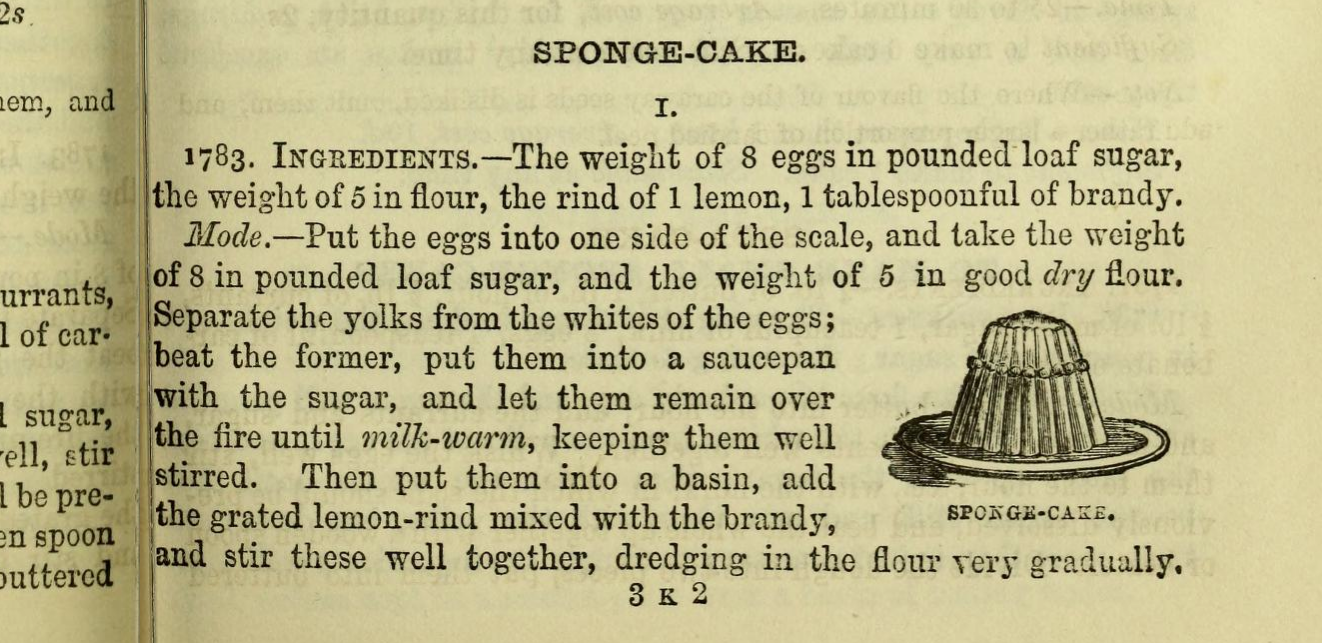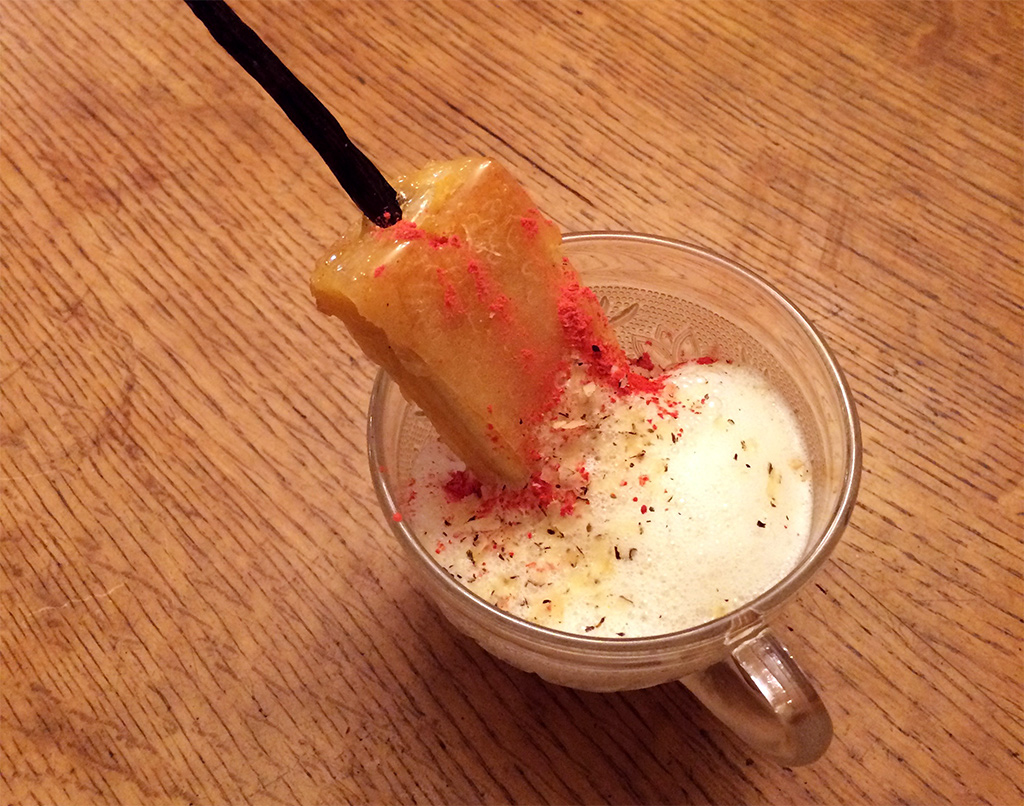026 | SPRING SPONGE CAKE, Tonka Bean, Dried Cherry, Vanilla Fragrance Alinea Restaurant cookbook recipe, pages 128-129.
I’m baaaack! I swear I’m finishing up this project soon…
Here’s my attempt at the recipe for SPONGE CAKE, Tonka Bean, Dried Cherry, Vanilla Fragrance from Alinea Restaurant in Chicago. It’s Alinea’s humorous take on traditional Victoria sponge cake — on a stick (actually a long vanilla bean), coated with a thin, clear layer of hard candy, sprinkled with dried cherry and grated tonka bean, and served with a delicious tonka bean cream and foam. It’s a cherry-vanilla cake pop — with a crunchy candy shell, and a side of danger!
Sponge Cake
Victoria sponge (aka ‘Victoria sandwich’ or ‘Victorian cake’) is a light, moist cake made with eggs, sugar, flour and fat. In the U.S. we think of it as ‘pound cake.’ England’s Queen Victoria loved the stuff at tea time. It is traditionally served with raspberry jam and whipped double or vanilla cream. This recipe deconstructs the basic elements of the Victoria sponge, and recombines them in a delicious, playful way…
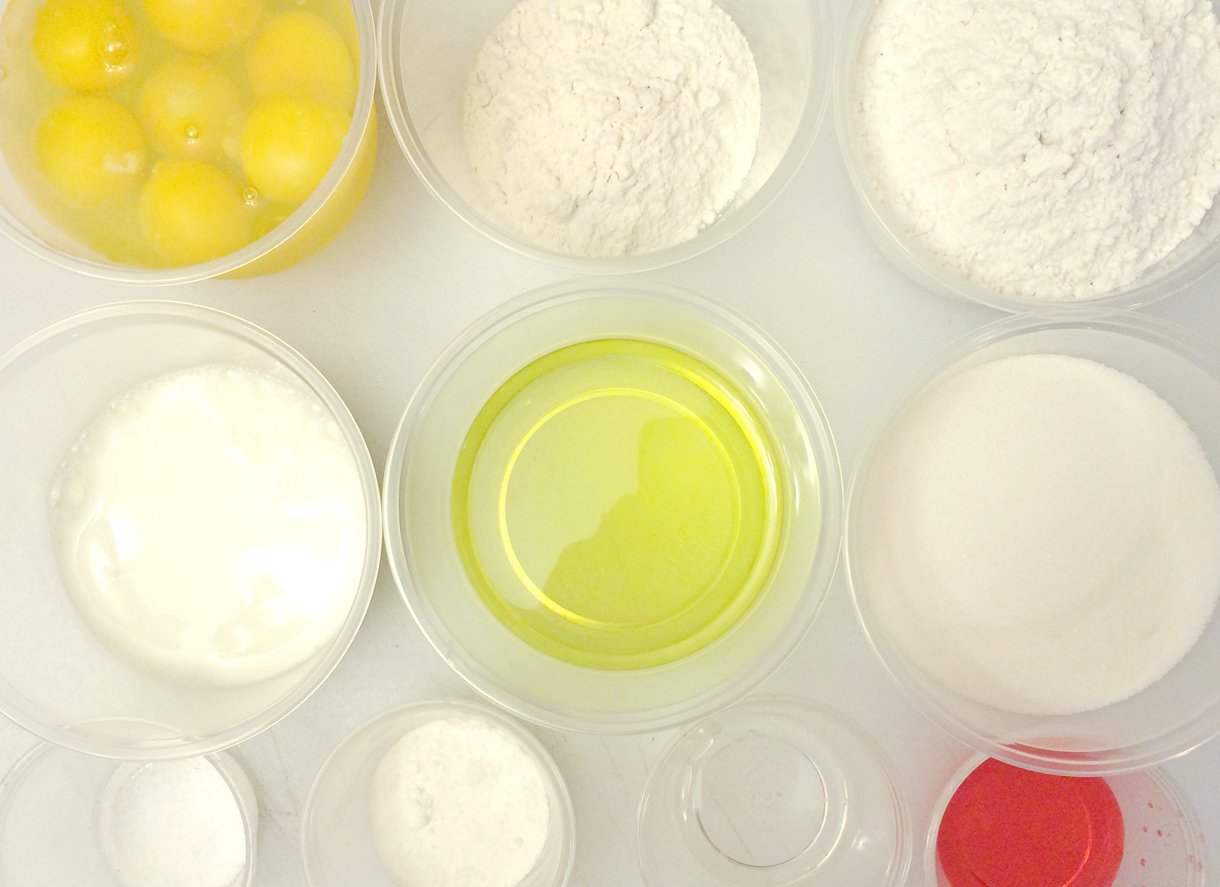
Mise en place for sponge cake.
I heated up the oven to 300ºF and prepared a halfsheet tray for baking with butter and flour. Then combined the eggs, sugar, Trimoline (We’re using Trimoline to keep the cake moist…), grapeseed oil and salt in the bowl of my KitchenAid mixer. Whipped ’em into shape for about three minutes with the wire attachment.
What is Trimoline?
Trimoline® is a registered brandname for an invert sugar syrup paste manufactured by Erstein. Made from beet and sugar syrups, it is very concentrated and thick, used to prevent crystallization, resists humidity, acts as an anti-oxidant, increases caramelization, improves texture, preserves aroma, flavor, and color. It is generally much sweeter than regular granulated sugar.
Inverted or invert sugar is a mixture of glucose and fructose. It’s made by splitting sucrose into its two components. “Compared with its precursor sucrose, inverted sugar is sweeter and its products tend to stay moist and are less prone to crystallization.” Invert sugar has a high affinity for water, and for this reason, it is used to keep products moist.
It works very well in sorbets and ice creams because it lowers the freezing point, virtually eliminating crystallization. Invert sugar acts as an emulsifier and helps stabilize the sorbet.
If you can’t find Trimoline, some on eGullet have suggested substituting honey, glucose paste or corn syrup. You can also try making your own. Other available brands of invert sugar syrup paste are Colorose, Honey-O, Inversol, Nulomoline and Nevuline.
Meanwhile I sifted together the cake flour and baking powder. Took the whipped egg mixture off the stand mixer and gently folded in the sifted flour. In a small bowl I combined the milk and cherry liquid, then stirred into my batter.
Poured the batter onto the baking tray and popped into the oven for 20 minutes. Removed and let cool.
Ingredients
King Arthur all-purpose flour
Eggs
Sugar
Trimoline (or glucose paste or corn syrup)
Grape seed oil
Kosher salt
King Arthur cake flour, sifted
Baking powder
Alta-Dena whole milk
Maraschino cherry liquid
About Tonka Beans
Kumaru (Dipteryx odoratais) is a species of flowering tree in the pea family, native to Central and South America. Its seeds are known as tonka beans (sometimes tonkin or tonquin beans), and have a vanilla and cherry-like flavor. As tonka beans may contain a high content of coumarin, an anticoagulant, they are regulated in food products within many countries including the US. In large, concentrated amounts, coumarin may cause hemorrhages, liver damage, or paralysis of the heart. Adverse affects are negligible or non-existent when consumed in small amounts.
Coumadin® brand of warfarin is a commercially manufactured anticoagulant used to prevent blood clots.
Yay! Let’s work with this terrifying ingredient!
Tonka Bean Cream
I re-hydrated the gelatin sheets in cold water, and squeezed out the excess. In a medium saucepan I combined the milk, cream, tonka beans, cherry liquid and sugar. I brought them all to a simmer, then added the gelatin sheets, stirring to dissolve the solids. Removed from the heat. In a large stainless bowl I whisked together the egg yolks and and salt, then slowly whisked in half the cream mixture to ‘temper’ the eggs. (If you add it all together quickly, you’ll just scramble the egg yolks and ruin your sauce…) Then whisked in the remainder and returned to very low heat on the stovetop. Whisk constantly with one hand while holding the rim of the stainless bowl in a towel or mitt with the other. I rotate the bowl while I do this to keep an even low heat over the thicken sauce. This technique works perfectly for egg sauces like hollandaise and sabayons.
After the sauce has emulsified a bit, the cookbook tells you to to immerse the pan in ice water. This cools it down fast enough to stop any cooking of the eggs that’s still going on.
At this point you can strain the tonka beans out and add the liquid to a ISO siphon canister if your’e foaming it.
I decided to forgo the siphon method, and thickened my tonka bean cream up with some more gelatin. It was not super light and foamy as it would have been coming out of a siphon, but more of a sour cream texture, which was fine for me. It tasted like vanilla cream with a hint of cherries. A very unique flavor. I was out of NO2 cartridges anyway…
This made a lot and I saved the rest for deserts.
Ingredients
Rousselot silver gelatin sheets
Alta-Dena whole milk
Alta-Dena heavy cream
Dried tonka beans
Maraschino cherry liquid
Sugar
Egg yolks
Kosher salt
Tonka Bean Froth
This component recipe is very similar to that for Tonka Bean Cream, but its ultimate form with be bubbly not foamy. In a medium saucepan I combined the milk, cream, soy lecithin, tonka beans and sugar. I brought the mixture to a simmer, whisking to dissolve all the solids. Then removed the saucepan to an ice bath to cool. When the liquid cooled to room temp, the tonka beans had infused their flavor. I strained this into a tall container and reserved for later. We’ll foam it up with an immersion circulator later. The soy lecithin provides elasticity to the bubbles, and delays them from popping too quickly.
Ingredients
Alta-Dena whole milk
Alta-Dena heavy cream
Soy lecithin powder
Dried toka beans
Sugar
Neutral Caramel Rectangles
When you say ‘caramel,’ I think of those golden brown cubes of chewy goodness from See’s Candies. Indeed, most of us associate the word with a amber-to-brownish color. Neutral caramel is supposed to be a thin layer of crystal-clear candy, carefully heated so as not to discolor. This recipe uses Isomalt, a sweet sugar substitute derived from beet sugar alcohols. Isomalt is used in the production of sugar-free candy, “especially hard-boiled candy, because it resists crystallization much better than the standard combinations of sucrose and corn syrup. It is used in sugar sculpture for the same reason.”
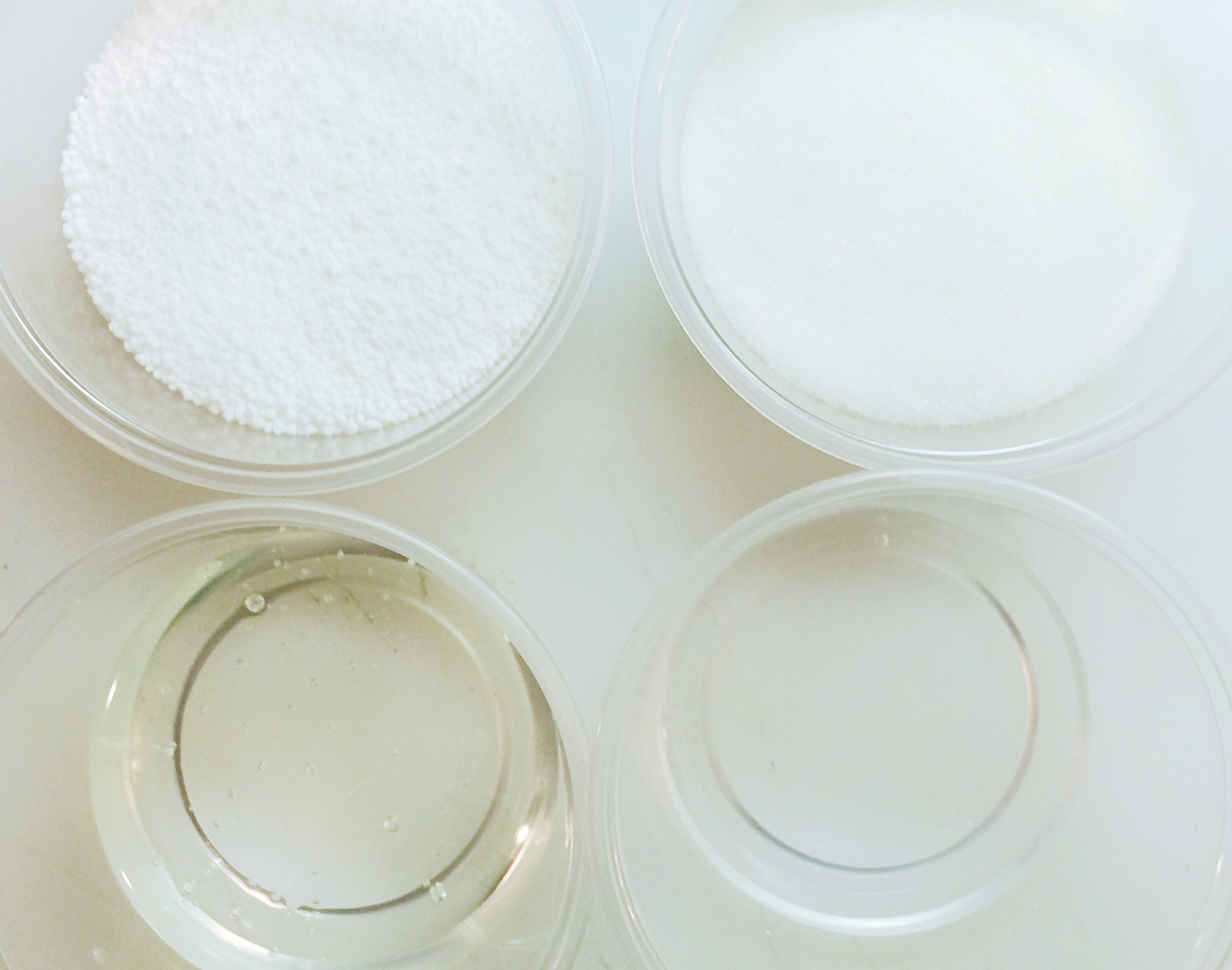
Mise en place for neutral caramel.
I combined the Isomalt, sugar, glucose and water, and brought to a boil. The neutral caramel in the cookbook is completely clear. Mine turned a bit yellow. It wasn’t until I was researching this post that I found out why. Many things can yellow the caramel. Gas burners at too high heat instead of a controlled heat with induction burner. The minerals in tap water. Wooden spoons and natural bristle brushes…
Here are some invaluable tips from Chef Dominic Palazzolo’s blog, MakeYourOwnMolds.
Use distilled water. The minerals in tap water can turn brown when exposed to elevated temperatures but because there is so little of these minerals it is perceived as a yellowing effect.
Use stainless steel pots and stainless steel utensils for stirring. Do not use a wooden spoon. Foreign materials in the wood leach out into the Isomalt which can turn the mixture yellow.
Do not cook less than three pounds of Isomalt at a time. Cooking small amounts of Isomalt creates too shallow a depth of material which can cause hot spots in your mixture and lead to premature yellowing.
Cook Isomalt on an appropriately sized burner. Electric [induction] burner should be slightly smaller than bottom of pot. When cooking with gas, flame should not creep up the side of the pot and remain on the bottom of the pot only. These precautions prevent overheating of the sides of the cooking pot which can cause premature yellowing. Using an induction range is the best way to cook Isomalt because it delivers heat only to the bottom of the pot.
Do not use a natural bristle brush to wash down the sides of the pot once Isomalt comes to a boil. Use a nylon pastry brush. There are a host of chemicals and conditioning agents in the natural bristles that can turn your Isomalt yellow.
Test your candy thermometer. Many of them read inaccurately. Test by bringing water to a boil and inserting thermometer and observe the temperature is shows. It should read 212ºF at sea level.
Cook Isomalt to 338ºF. Take off heat at about 333ºF and place bottom of pot in water to stop the cooking process. Allow the pot to stay in water only until the hissing stops — about 5 seconds.
Source: Dominic Palazzolo

Then poured out on a silpat mat to cool. Broke in pieces small enough to fit into my spice grinder.

Ground to a fine white powder.

Reserved to an airtight plastic container. Can save for awhile too!

To make the thin neutral caramel “tuile” squares, I sifted the powder onto a silpat mat, then heated in a low oven until it had just meltd again. Then removed to cool

But I sifted it waaay too thick. I found out you don’t need much! I could have ground it up and remelted it once more (think “Live, Die, Repeat”), but I’m too lazy for that. Just remember, the thinner the layer the better…

Ingredients
Powdered Isomalt
Granulated Sugar
Glucose
Water
Assembly
Let’s make some frikken cake pops! I cut the sponge cake into long rectangles, impaled each with a long vanilla pos, then placed a thin sheet of the neutral caramel atop each. The tuiles have to extend over the sides of the cake, so when heated, the sugar “encases” the cake. I put into a warm oven just long enough to melt the sugar, and removed to let cool.
Flip ’em over and repeat! Then you’ll have cake pops fully encased in a hard sugar coating. Just like an ice cream treat is encased in hard chocolate…
I used some antique punch glasses, but you can use whatever you’d like. In the cup, I added a generous dollop of Tonka Bean Cream, and placed the cake pops in each. Then whipped up the Tonka Bean Foam with an immersion blender and added to the top of the cream. Sprinkled some grated freeze-dried cherries over and topped with a bit of freshly grated tonka bean.
There we go — fancy-schmancy cake pops fit for good old Queen Victoria herself!
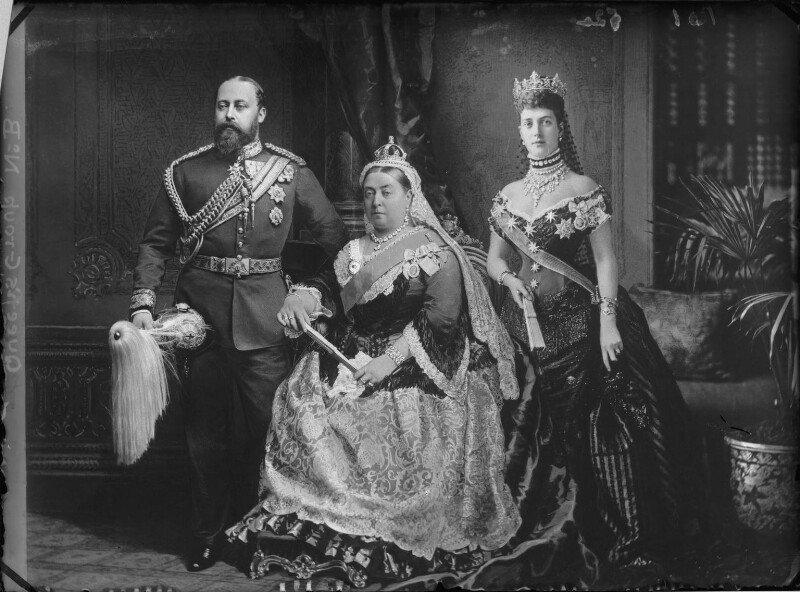
King Edward VII, Queen Victoria and Queen Alexandra, photographed by Alexander Bassano, c1883. © National Portrait Gallery, London. Used with permission.
Ingredients
Dried vanilla beans
1 Dried tonka bean
Freeze-dried cherries
Yields: Enough to make at least 12 cake pops. (Maybe 24 if you’ve got enough vanilla beans…)
Serveware
Any ol’ glass will do
Equipment
Cutting board and kitchen knife
Salter digital scale
Measuring cup, spoons
Cuisinart SmartStick immersion blender
Kitchen sieve or chinois
Wire whisk
Rubber spatula
Pastry brush
Small and medium sauce pans
Full and halfsheet cooking trays
Silpat silicone baking mat
Plastic containers

